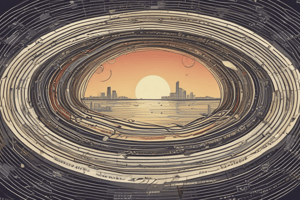Podcast
Questions and Answers
Households are the only sector that receives income in the circular flow of the economy.
Households are the only sector that receives income in the circular flow of the economy.
False (B)
What is the primary role of financial institutions in the circular flow of the economy?
What is the primary role of financial institutions in the circular flow of the economy?
Financial institutions facilitate savings, investments, and loans, connecting lenders and borrowers.
Which of the following is NOT a component of government expenditures?
Which of the following is NOT a component of government expenditures?
- Funding for infrastructure projects
- Social security payments
- Profits from government-owned businesses (correct)
- Salaries for government employees
The decision to allocate money for future needs or goals is called ______.
The decision to allocate money for future needs or goals is called ______.
Match the economic sector with its corresponding function in the circular flow:
Match the economic sector with its corresponding function in the circular flow:
Flashcards
Households
Households
Entities that provide labor, consume goods, and earn income.
Businesses
Businesses
Organizations that produce goods/services and pay wages in return.
Government
Government
Authority that collects taxes, provides public services, and invests.
Financial Institutions
Financial Institutions
Signup and view all the flashcards
Investment
Investment
Signup and view all the flashcards
Study Notes
Circular Flow of the Economy
- Households provide labor and consume goods and services
- Businesses produce goods and services, paying wages
- Government collects taxes and provides public services
- Financial institutions facilitate savings, investments, and loans
- Income is derived from wages or salary, contributing to financial stability and standard of living
- Expenditures are categorized into fixed (unchanging), variable (fluctuating), discretionary (nonessential), and mandatory (required) expenses
Different Sectors
- Households: Provide labor; consume goods and services
- Businesses: Produce goods and services; pay wages
- Government: Collect taxes; provide public services
- Financial Institutions: Facilitate savings, investments, and loans
Terms
- Income: Money earned (wages, salaries, investments)
- Expenditures: Money spent on goods, services, and investments
- Fixed Expenses: Unchanging expenses
- Variable Expenses: Expenses that fluctuate
- Discretionary Expenses: Nonessential expenses
- Mandatory Expenses: Required expenses (e.g., taxes)
- Savings: Portion of income set aside for future goals
- Investments: Allocating money for future returns, considering risk levels
Consumption
- People use goods and services to meet needs and wants
- Durable goods last a long time
- Non-durable goods are used once
- Income is needed for consumption
Savings
- Portion of money saved for future needs
- Portion of money invested for future returns/profit
Investments
- Allocating money to earn future returns
- Risk-reward trade-off is essential
Government Role
- Collect taxes to fund public services
- Provides public services
- Plays a role in financial stability and standard of living
Studying That Suits You
Use AI to generate personalized quizzes and flashcards to suit your learning preferences.




